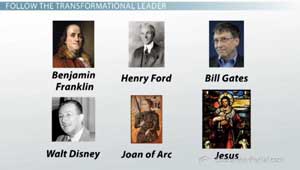The Transformational Leader - Quiz
Choose your answer and write the correct one down. Then click HERE for the answers to this quiz.
NOTE: The transcript from the video is listed below the quiz for your reference.
1. The transformational leader uses all of these to convince employees to transcend their personal interests for the sake of the larger organization except
- Charisma
- Coercion
- Individualized consideration
- Intellectual stimulation
- Enthusiasm
2. Encouraging creativity and innovation when formulating potential solutions to organizational problems refers to this element of transformational leadership
- Vision
- Impression management
- Individualized consideration
- Intellectual stimulation
-
Strategic planning
3. What sets the transformational leader apart from many other leadership styles is their ability to influence others to follow them through vision, framing, and impression management.
- TRUE
- FALSE
4. ________ is central to any transformational leader's goal for the reason that before anyone can follow a leader, they need to have an idea of where they are going and why.
- Vision
- Charisma
- Intellectual stimulation
- Impression management
- Formal education
5. This is what the transformational leader will use to control how they are viewed by their followers
- Vision
- Framing
- Impression management
- Charisma
- The force
Transformational leaders are known for their innovation and influence. In this video, you'll explore the management styles and traits that contribute to their success.
More than Meets the Eye
If you can remember watching Transformers on TV as a child, or perhaps you have seen some of the newer blockbuster Transformer hit movies in recent years, you should be familiar with the phrase 'more than meets the eye.' If not, perhaps the phrase 'don't judge a book by its cover' or 'don't take things at face value' are more relatable for you. Any of these phrases gets to the idea that our initial impressions of someone or something may not be completely accurate - that buried deep below the surface there lies more than what we initially can see. This is the premise of the transformational leader, who works continuously to expose the potential of followers and the organization to bring them to the next level of success.
 |
The Transformational Leader
Much like a breath of fresh air, the transformational leader creates enthusiasm and revitalizes organizations. This enthusiasm is generated in several ways. First, transformational leaders use what's called idealized influence to demonstrate to followers that the leader can walk the walk and talk the talk. Essentially, the transformational leader serves as a role model to followers by living by the same principles that he or she expects of their followers. The transformational leader would never expect followers to do something that he or she would not do themselves.
 |
Second, the transformational leader is also a charismatic leader, who has the ability to arouse a sense of excitement, motivation and assurance in followers. Keep in mind while transformational leaders are charismatic, they are not as narcissistic as pure charismatic leaders can be.
Third, transformational leaders show a genuine concern for the needs and feelings of their followers through something called individualized consideration. Examples of individualized consideration include things like mentoring employees one-on-one, delegating difficult tasks to deserving people and maintaining a high level of communication with followers. Each follower is treated as an individual. The transformational leader spends time recognizing the differences in followers.
Fourth, the transformational leader is intellectually stimulating by encouraging creativity and innovation when formulating potential solutions to organizational problems. By allowing the followers to participate in this unrestricted fashion, the transformational leader is able to stir the imagination of followers in a way that promotes the prompt identification of problems and high-quality solutions that are implemented with the full commitment of followers. Given that much of the transformational leader's time is spent trying to convince followers to transcend their personal interests for the sake of the larger organization, idealized influence, charisma, individualized consideration and intellectual stimulation are essential.
 |
Follow the Transformational Leader
While idealized influence, charisma, individualized consideration and intellectual stimulation certainly pave the way for the transformational leader to gain the support of followers, much like the Transformers, there is more than meets the eye when it comes to transformational leadership. What sets the transformational leader apart from many other leadership styles is the ability to influence others to follow them through vision, framing and impression management.
Vision is central to any transformational leader's goal for the reason that before anyone can follow a leader they need to have an idea of where they are going and why. The transformational leader will paint the picture of the desirable future for followers, detailing out their individual role in the process and how they will be affected by the change in addition to binding the greater group together to work towards the shared goal.
Framing is used by the transformational leader to provide followers with a game plan in highly-measureable terms for how they will accomplish their tasks, which will aid in the achievement of some organizational goal.
Impression management refers to the steps that a transformational leader will take to control how they are viewed by their followers. Clearly, a leader wants to be seen as competent, knowledgeable and deserving of their role in the organization; however, the transformational leader makes a conscious effort to be transparent and regarded as all of those things and more so that they can really continue to influence their followers.
 |
Once a leader is seen as charismatic, trustworthy, confident, admirable and committed to the organization, followers are more than willing to identify with the leader and their vision. The transformational leader will use contingent rewards, or rewards based on meeting some established goal, to acknowledge the efforts of followers when they are aligned with the vision. They also practice management by exception by providing autonomy to followers and intervening only when there is a problem. Followers are converted into leaders by the transformational leader, who empowers them to commit to actions that align with the vision.
Transformational Leaders in Today's Workplace
In today's workplace, transformational leaders are prolific and perhaps the most common leadership style across industries. Transformational leaders are relevant in contemporary business due to their flexible, innovative, inspirational and change-savvy personas. When it comes to creating and sustaining the competitive advantage, the transformational leadership style is most effective due to the ability to transcend the status quo and bring organizations into their desirable future. To better understand the transformational leader we can look to several famous examples including: Benjamin Franklin, Henry Ford, Bill Gates, Walt Disney, Joan of Arc, Jesus, Sam Walton, Phil Jackson, Abraham Lincoln, Socrates, Jack Welsh, Herb Kelleher and many more.
 |
Lesson Summary
Let's review. The transformational leader spends much of their time trying to convince employees to transcend their personal interests for the sake of the larger organization. This is accomplished in several ways including: idealized influence, charisma, individualized consideration and intellectual stimulation. Idealized influence involves the transformational leader serving as a role model to followers by living by the same principles that he or she expects of their followers. Charisma shows the leader's ability to arouse a sense of excitement, motivation and assurance in followers. Individualized consideration is used by the transformational leader to show a genuine concern for the needs and feelings of followers. Finally, the transformational leader is intellectually stimulating by encouraging creativity and innovation when formulating potential solutions to organizational problems.
What sets transformational leaders apart from many other leadership styles is their ability to influence others to follow them through vision, framing and impression management. Vision is central to any transformational leader's goal for the reason that before anyone can follow a leader they need to have an idea of where they are going and why. Framing is used by the transformational leader to provide followers with a game plan in highly measureable terms for how they will accomplish their tasks which aid in the achievement of some organizational goal. Impression management refers to the steps a transformational leader will take to really try to control how they are viewed by their followers.
Transformational leaders are relevant in contemporary business due to their flexible, innovative, inspirational and change savvy personas. When it comes to creating and sustaining the competitive advantage, the transformational leadership style is most effective due to the ability to transcend the status quo and bring organizations into their desirable future.